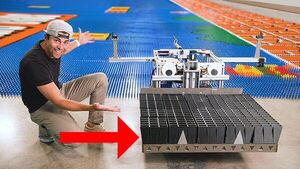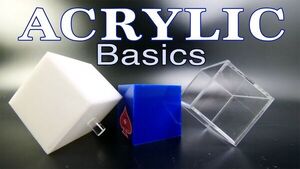2021-07-29 - Nº 326
Editorial
Esta é a Newsletter Nº 326 que se apresenta com o mesmo formato que as anteriores. Se gostar da Newsletter partilhe-a!
Todas as Newsletters encontram-se indexadas no link.
Esta Newsletter tem os seguintes tópicos:
Faz hoje anos que nascia, em 1796, o inventor norte-americano Walter Hunt. Ele concebeu a primeira espingarda de repetição. Hunt começou a inventar no final da adolescência uma máquina para fiar linho, que patenteou em 1826. Inventou também um gongo para bombeiros (1827), uma serra florestal, um fogão que queimava carvão duro. Em 1834, inventou uma máquina de costura com ponto de fechadura, que não patenteou até ser demasiado tarde. Embora as suas invenções valessem a pena, ele não as conseguiu comercializar eficazmente. Em 1849, Hunt fez o primeiro alfinete de segurança a partir de um pedaço de arame de latão com cerca de oito polegadas de comprimento, enrolado no centro e protegido numa extremidade. Patenteou esta invenção como um "alfinete de vestuário", e vendeu os direitos sobre ela por 400 dólares. O seu desenho de espingarda de 1849 tinha um carregador tubular por baixo do cano utilizado com as suas munições de bola "foguete" auto-propulsionadas.
Faz também hoje anos que nascia, em 1898, o físico austríaco-americano Isidor Isaac Rabi. Ele recebeu o Prémio Nobel da Física em 1944 pela sua invenção (em 1937) do método de ressonância magnética atómica e de feixe molecular para medir as propriedades magnéticas dos átomos, moléculas, e núcleos atómicos. Passou a maior parte da sua vida na Universidade de Columbia (1929-67), onde realizou a maior parte da sua investigação pioneira em radar e no momento magnético associado ao spin de electrões nas décadas de 1930 e 1940. O seu trabalho vencedor do Nobel levou à invenção do laser, do relógio atómico, e aos usos diagnósticos da ressonância magnética nuclear. Foi ele que deu origem à ideia do centro de investigação nuclear CERN em Genebra (fundado em 1954).
Faz igualmente hoje anos que nascia, em 1914, o inventor francês Marcel Bich. Ele construiu o seu império empresarial criando canetas, laminas de barbear e isqueiros Bic descartáveis. Em 1945, Marcel Bich e o seu amigo, Edouard Buffard, adquiriram uma fábrica vazia perto de Paris, França, e logo desenvolveram um próspero negócio, produzindo peças para canetas de tinta permanente e lápis mecânicos de chumbo. Mais tarde, Bich passou dois anos a desenvolver o seu desenho de esferográficas, e em 1949, conseguiu produzir uma esferográfica fiável e de baixo custo. Em 1973, o isqueiro Bic foi introduzido nos EUA, seguido de Bic Shavers, introduzido pela primeira vez em 1976.
Por fim, faz hoje anos que nascia, em 1917, o físico inglês Harry Boot. Ele trabalhou com John Randall no desenvolvimento do magnetrão da cavidade, o dispositivo gerador de micro-ondas utilizado no radar. Isto deu uma grande contribuição para vencer a Segunda Guerra Mundial. Os magnetrões anteriores feitos na década de 1920 davam uma baixa potência de saída. Em Fevereiro de 1940, os avanços de Randall e Boot na concepção do magnetrão de cavidade de pequeno tamanho, produziram comprimentos de onda de centímetros a uma potência muito superior, o que permitiu ao radar detectar objectos mais pequenos. Por sua vez, este equipamento mais compacto com uma antena mais pequena permitiu a fácil instalação móvel de radar de alta resolução em aeronaves.
Nesta semana que passou foi enviado para a estação espacial internacional um novo módulo russo. Devido a um problema técnico na acoplagem o módulo, chamado Nauka, começou a disparar inesperadamente os seus propulsores - o que fez com que toda a estação ficasse fora de posição. O módulo científico há muito esperado já tinha encontrado várias questões técnicas no seu caminho para a ISS, mas uma vez atracado na estação espacial na quinta-feira de manhã, parecia estar ok. Depois cerca de três horas após a sua chegada - por volta das 12:34 ET - Nauka começou subitamente a disparar os seus propulsores. Os astronautas da ISS disseram aos controladores de voo que estavam a ver algo estranho pelas suas janelas. Em resposta à falha, os controladores de voo começaram a disparar propulsores sobre duas outras partes do lado russo do ISS, incluindo o módulo de serviço, naquilo a que chamaram um "tug of war" para colocar a estação de novo na sua posição normal. Às 13h30 ET, os controladores de voo da ISS anunciaram que os propulsores da Nauka tinham finalmente parado de disparar e tinham recuperado o controlo do posicionamento da estação. Durante essa hora, Nauka tinha rodado a estação 45 graus.
Na Newsletter desta semana apresentamos diversas noticias, artigos científicos, projetos de maker assim como alguns videos interessantes. São apresentadas as revistas Hackspace Magazine nº 45 e a MagPI Nº107 de Agosto.
 João Alves ([email protected])
João Alves ([email protected])
O conteúdo da Newsletter encontra-se sob a licença  Creative Commons Attribution-NonCommercial-ShareAlike 4.0 International License.
Creative Commons Attribution-NonCommercial-ShareAlike 4.0 International License.
Novidades da Semana
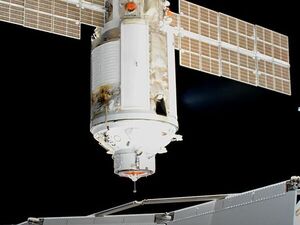
Russia's new space-station module fired its engines in error, pushing the entire station into an hour-long spin
"A new Russian space-station module malfunctioned after it docked on Thursday. The module, called Nauka, starting unexpectedly firing its thrusters — which moved the entire station out of position. The long-awaited science module had already encountered several technical issues on its way to the ISS, but once it docked to the space station on Thursday morning, it seemed to be in the clear. Then about three hours after its arrival — at about 12:34 p.m. ET — Nauka suddenly began firing its thrusters. Astronauts on the ISS told flight controllers they were seeing something strange out their windows." [...]
Outras Notícias
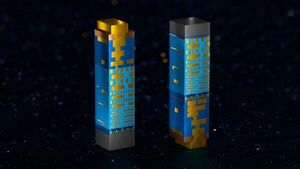
Intel Accelerates Process and Packaging Innovations
"Intel Corporation today revealed one of the most detailed process and packaging technology roadmaps the company has ever provided, showcasing a series of foundational innovations that will power products through 2025 and beyond. In addition to announcing RibbonFET, its first new transistor architecture in more than a decade, and PowerVia, an industry-first new backside power delivery method, the company highlighted its planned swift adoption of next-generation extreme ultraviolet lithography (EUV), referred to as High Numerical Aperture (High NA) EUV. Intel is positioned to receive the first High NA EUV production tool in the industry. “Building on Intel’s unquestioned leadership in advanced packaging, we are accelerating our innovation roadmap to ensure we are on a clear path to process performance leadership by 2025,” Intel CEO Pat Gelsinger said during the global “Intel Accelerated” webcast. “We are leveraging our unparalleled pipeline of innovation to deliver technology advances from the transistor up to the system level. Until the periodic table is exhausted, we will be relentless in our pursuit of Moore’s Law and our path to innovate with the magic of silicon.” The industry has long recognized that traditional nanometer-based process node naming stopped matching the actual gate-length metric in 1997." [...]
Replace Silicon IGBTs with Industry’s Most Rugged Silicon Carbide Power Solutions Now Available at 1700V
"Today’s energy-efficient electric charging systems powering commercial vehicle propulsion, as well as auxiliary power systems, solar inverters, solid-state transformers and other transportation and industrial applications all rely on high-voltage switching power devices. To meet these requirements, Microchip Technology Inc. (Nasdaq: MCHP) today announced the expansion of its silicon carbide portfolio with a family of high-efficiency, high-reliability 1700V silicon carbide MOSFET die, discrete and power modules. Microchip’s 1700V silicon carbide technology is an alternative to silicon IGBTs. The earlier technology required designers to compromise performance and use complicated topologies due to restrictions on switching frequency by lossy silicon IGBTs. In addition, the size and weight of power electronic systems are bloated by transformers, which can only be reduced in size by increasing switching frequency. The new silicon carbide product family allows engineers to move beyond IGBTs, instead using two-level topologies with reduced part count, greater efficiency and simpler control schemes." [...]

Maxim Integrated Teams with Xailient to Provide World’s Fastest and Lowest-Power IoT Face Detection
"MAX78000 AI microcontroller and Xailient's Detectum neural network detects and localizes faces in video and images at just 12ms per inference Maxim Integrated Products, Inc. (NASDAQ: MXIM) and Xailient Inc., a company focused on artificial intelligence (AI) for the edge, today announced that Maxim Integrated's MAX78000 ultra-low power neural-network microcontroller detects and localizes faces in video and images using Xailient's proprietary Detectum™ neural network. Xailient's neural network draws 250x lower power (at just 280 microJoules) than conventional embedded solutions, and at 12 milliseconds (ms) per inference, the network performs in real time and is faster than the most efficient face-detection solution available for the edge. Battery-powered AI systems that require face detection, such as home cameras, industrial grade smart security cameras and retail solutions, require a low-power solution to provide the longest possible operation between charges. In addition to supporting standalone applications, Maxim Integrated's microcontroller paired with Xailient's neural network improves overall power efficiency and battery life of hybrid edge/cloud applications that employ a low-power 'listening' mode which then awakens more complex systems when a face is detected. Xailient's Detectum neural network includes focus, zoom and visual wake-word technologies to detect and localize faces in video and images at 76x faster rates than conventional software solutions, at similar or better accuracy. In addition, the flexible network can be extended to applications other than facial recognition, such as livestock inventory and monitoring, parking spot occupancy, inventory levels and more." [...]
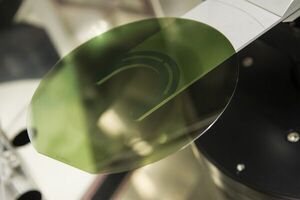
STMicroelectronics Manufactures First 200mm Silicon Carbide Wafers
"Transition to 200m wafers marks milestone in capacity build-up to support automotive and industrial markets in the electrification of their systems and products STMicroelectronics (NYSE: STM), a global semiconductor leader serving customers across the spectrum of electronics applications, today announced it has manufactured the first 200mm (8-inch) Silicon-Carbide (SiC) bulk wafers for prototyping next-generation power devices from its facility in Norrköping, Sweden. The transition to 200mm SiC wafers marks an important milestone in the capacity build-up for ST’s customer programs in automotive and industrial sectors and will consolidate ST’s lead in the disruptive semiconductor technology that allows for smaller, lighter, and more efficient power electronics with a lower total cost of ownership. Among the first in the world, ST’s initial 200mm SiC wafers are also very high quality, with minimal yield-impacting and crystal-dislocation defects. The low defectivity has been achieved by building on the excellent know-how and expertise in SiC ingot growth technology developed by STMicroelectronics Silicon Carbide A.B. (formerly Norstel A.B., which ST acquired in 2019). In addition to meeting the quality challenge, the transition to 200mm SiC substrates requires a step forward in manufacturing equipment and the overall support ecosystem performance." [...]

Renesas and Syntiant Develop Voice-Controlled Multimodal AI Solution Combining Advanced Vision and Voice Technologies
"New Offering Enables Low-Power Voice-Controlled Operation of Embedded Vision AI Systems in IoT and Edge Applications Renesas Electronics Corporation (TSE:6723), a premier supplier of advanced semiconductor solutions, and Syntiant Corp., a deep learning chip technology company advancing low-power intelligent voice and sensor processing in edge devices, today announced the joint development of a voice-controlled multimodal AI solution that enables low-power contactless operation for image processing in vision AI-based IoT and edge systems, such as self-checkout machines, security cameras, and video conference systems, and smart appliances such as robotic cleaning devices. The new solution combines the Renesas RZ/V Series vision AI microprocessor unit (MPU) and the low-power multimodal, multi-feature Syntiant® NDP120 Neural Decision Processor™ to deliver advanced voice and image processing capabilities. The joint solution features always-on functionality with quick voice-triggered activation from standby mode to perform object recognition, facial recognition, and other vision-based tasks that are critical functions in security cameras and other systems. For example, while user-defined voice cues drive activation and system operation, vision AI recognition tracks operator behavior and controls operation or issues a warning when suspicious actions are detected. The multimodal architecture makes it easier to create contactless user experiences for vision AI-based systems. Using a dedicated, power-efficient chip for voice recognition reduces standby power consumption while speeding up system development because it is possible to develop software independently of the vision AI functionality." [...]
ON Semiconductor 16 Mp XGS Sensor Brings High Quality, Low Power Imaging to Factory Automation and Intelligent Transportation Systems (ITS)
"Recently integrated into the Toshiba Teli industrial camera family, the XGS 16000 offers one of the highest resolutions available for compact 29 x 29 mm cameras ON Semiconductor (Nasdaq:ON) introduced the latest addition to the XGS series of CMOS image sensors. The XGS 16000 is a 16 Megapixel (Mp) sensor that provides high quality, global shutter imaging for factory automation applications including robotics and inspection systems. Consuming only 1 Watt at 65 frames per second (fps), the XGS 16000 delivers exceptional performance at low power. This makes the XGS 16000 one of the best in class for power consumption, while also offering one of the highest resolutions available for standard 29 x 29 mm industrial cameras. The XGS 16000 shares a common architecture and footprint with other XGS CMOS image sensors. This enables manufacturers to use a single camera design to develop products in different resolutions." [...]
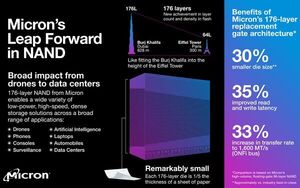
Micron Launches World’s First 176-Layer NAND in Mobile Solutions to Power Lightning-Fast 5G Experiences
"Micron Technology, Inc., (Nasdaq: MU) announced today it has begun volume shipments of the world’s first 176-layer NAND Universal Flash Storage (UFS) 3.1 mobile solution. Engineered for high-end and flagship phones, Micron’s discrete UFS 3.1 mobile NAND unlocks 5G’s potential with up to 75% faster sequential write and random read performance than prior generations,1 enabling downloads of two-hour 4K movies2 in as little as 9.6 seconds. Micron’s 176-layer NAND offers a compact design ideal for the high capacity, small form factors required in mobile devices. This launch follows quickly on the heels of Micron’s volume delivery of PCIe Gen4 solid-state drives with 176-layer NAND in June, bringing high performance, design flexibility and low power consumption to professional workstations and ultrathin notebooks. Now available for smartphones, Micron’s industry-pioneering advanced NAND technology and performance enables a more responsive mobile experience with true multitasking across apps. “5G delivers multigigabit speeds to mobile devices, and a high-performance hardware foundation is critical to powering these lightning-fast mobile experiences,” said Raj Talluri, senior vice president and general manager of Micron’s Mobile Business Unit." [...]

First Single-Chip Network Synchronization Solution Provides Ultra Precise Timing for 5G Radio Access Equipment
"Combines integration and performance in one compact, low-power device supported by Microchip’s widely deployed IEEE 1588 Precision Time Protocol (PTP) and synchronization algorithm software modules 5G technology requires time sources to be synchronized throughout a packet-switched network ten times more accurately than 4G requirements. Microchip Technology Inc. (Nasdaq: MCHP) now makes it possible to achieve 5G performance with the first single-chip, highly integrated, low-power, multi-channel integrated circuit (IC) coupled with the company’s widely adopted and reliable IEEE® 1588 Precision Time Protocol (PTP) and clock recovery algorithm software modules. “Our newest ZL3073x/63x/64x network synchronization platform implements sophisticated measure, calibrate and tune capabilities, thereby significantly reducing network equipment time error to meet the most stringent 5G requirements,” said Rami Kanama, vice president of Microchip’s timing and communications business unit. “A uniquely flexible architecture for implementing the necessary channel density as well as high-performance, low-jitter synthesizers help simplify the design of timing cards, line cards, Radio Units (RU), Centralized Units (CUs) and Distributed Units (DUs) for 5G Radio Access Networks (RAN).” Microchip’s measure, calibrate and tune capabilities ensure 5G systems achieve International Telecommunication Union – Telecommunication (ITU-T) Standard G.8273.2 Class C (30ns max|TE|) and the emerging Class D (5ns max|TEL|) time error requirements. The architecture provides flexibility, offering up to five independent Digital Phase Locked Loop (DPLL) channels while consuming only 0.9W of power in a compact 9 x 9-millimeter package that simultaneously reduces board space, power and system complexity. With five ultra-low-jitter synthesizers, this latest platform offers 100 femtosecond (fs) root mean square (rms) jitter performance required by high-speed interfaces in the latest 5G RU, DU and CU systems." [...]

World’s most powerful tidal turbine, the O2, starts exporting clean power
"Orbital Marine Power’s O2, the world’s most powerful tidal turbine, has commenced grid connected power generation at the European Marine... Orbital Marine Power’s O2, the world’s most powerful tidal turbine, has commenced grid connected power generation at the European Marine Energy Centre (EMEC) in Orkney. The innovative, floating turbine is anchored in the Fall of Warness where a subsea cable connects the 2MW offshore unit to the local onshore electricity network. Manufactured and launched in Dundee earlier in the year before being towed up to Orkney, the O2 is Orbital’s first commercial turbine and represents the culmination of more than 15 years of world leading product development in the UK. The 74m long turbine is expected to operate in the waters off Orkney for the next 15 years with the capacity to meet the annual electricity demand of around 2,000 UK homes with clean, predictable power from the fast-flowing waters. In a further ground-breaking element of the project, the O2 is to provide power to EMEC’s onshore electrolyser to generate green hydrogen that will be used to demonstrate decarbonisation of wider energy requirements. Orbital CEO, Andrew Scott, said: “This is a major milestone for the O2 and I would like to commend the whole team at Orbital and our supply chain for delivering this pioneering renewable energy project safely and successfully." [...]
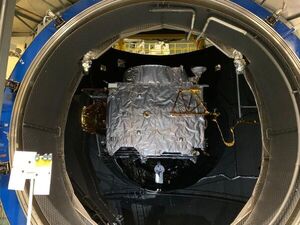
Jupiter mission passes space vacuum test
"ESA’s Juice mission to Jupiter has successfully endured a month of space-like conditions inside the Large Space Simulator, the largest vacuum chamber in Europe. At 10 m wide and 15 m high, the Large Space Simulator (LSS) is big enough to accommodate an upended London double decker bus. It is part of ESA’s ESTEC Test Centre in the Netherlands, the largest satellite testing facility in Europe. The flight model of the Jupiter Icy Moons Explorer, Juice, was exposed to vacuum a billion times lower than standard seal level pressure, along with representative temperature extremes the spacecraft will encounter on its journey to Jupiter, ranging from 250°C to -180 °C. The LSS’s artificial Sun simulator recreated the searing sunlight Juice will experience during its 88-month cruise phase, which will include a flyby of Venus. Liquid nitrogen circulating through the walls of the chamber mimicked the chill of deep space." [...]

Rolls-Royce generator delivered for most powerful hybrid-electric propulsion system in aerospace
"The generator that will be at the heart of the most powerful hybrid-electric aero power and propulsion system in aerospace has arrived for installation at our specialist testbed. The generator, and related power electronics, was delivered to the newly-renovated Testbed 108 in Bristol, UK, from the Rolls-Royce facility in Trondheim, Norway, having completed an extensive development test programme. It will form part of the 2.5 megawatt (MW) Power Generation System 1 (PGS1) demonstrator programme, for future regional aircraft. In addition to hybrid-electric propulsion, the generator could also be used as part of a “more-electric” system for larger aircraft or within future ground or marine applications. PGS1 forms an important element of our sustainability strategy, which includes developing innovative electrical power and propulsion systems. Rolls-Royce has already tested the AE2100 engine element, specialist controls and thermal management system at Testbed 108." [...]

Joby Begins Journey to Becoming First eVTOL Airline
"Kicks off FAA Part 135 air carrier certification process; now in first of five stages towards becoming certified airline; expects to achieve certification in 2022 Joby Aero Inc. (“Joby”), a California-based company developing all-electric aircraft for commercial passenger service, today announced it had taken the first step towards building the first eVTOL airline, by beginning the process to receive a Part 135 Air Carrier Certificate issued by the Federal Aviation Administration (“FAA”). A Part 135 Air Carrier Certificate is required for Joby to operate its revolutionary aircraft as an air taxi service in cities and communities around the United States. Alongside a Type Certificate and Production Certificate, this is one of three regulatory approvals critical to the planned launch of Joby’s all-electric aerial ridesharing service in 2024. The Company is now in the first of five stages necessary for Joby to achieve Part 135 certification in 2022. It expects to start the next stage of the process in August, with the submission of additional application materials including the full complement of airline operating manuals. Once that documentation is approved, the FAA will visit Joby locations to observe training sessions and witness flight operations before issuing its final approval." [...]

Boeing Starliner OFT-2 launch to space station delayed following Russian module mishap
"Boeing's Starliner spacecraft will have to wait to make its triumphant trip to space. Today (July 29), officials at NASA and Boeing announced that Boeing's uncrewed Orbital Flight Test 2 (OFT-2) mission for its Starliner astronaut taxi will be delayed from Friday (July 30) to Tuesday (Aug. 3). The Aug. 3 liftoff is scheduled to take place at 1:20 p.m. EDT (1720 GMT), NASA Commercial Crew Program manager Steve Stich said in a news conference today. This delay follows a mishap with Russia's Nauka module, which docked with the International Space Station this morning. "NASA and Boeing have decided to stand down from Friday's launch attempt of the agency's Orbital Flight Test-2 mission," NASA wrote in a statement. "Currently, launch teams are assessing the next available opportunity." [...]

Aerial Scouting of ‘Raised Ridges’ for Ingenuity’s Flight 10
"Ingenuity has come a long way from its original airfield, “Wright Brothers Field,” which is 0.64 miles (1.04 kilometers) to the northeast of our current location. We got here during Flight 9, an endeavor that had our helicopter breaking several of our own records as we relocated to the far side of the "Séítah" geologic unit. Covering 2,051 feet (625 meters), Flight 9 was executed so that Ingenuity could provide valuable imagery and information for the Perseverance science team. Flight 10 will allow us to reap the benefits of our previous flight. Scheduled for no earlier than this Saturday (July 24), Flight 10 will target an area called the "Raised Ridges" (RR), named for the geographic features that start approximately 164 feet (50 meters) south-by-southwest of our current location. We will be imaging Raised Ridges because it’s an area that Perseverance scientists find intriguing and are considering visiting sometime in the future." [...]
Ciência e Tecnologia
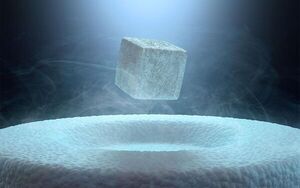
A Super New Theory
"A researcher at the University of Tsukuba introduces a new theoretical model of high-temperature superconductivity, in which electrical current can flow with zero resistance, that may lead to extremely efficient energy generation and transmission A scientist from the Division of Quantum Condensed Matter Physics at the University of Tsukuba has formulated a new theory of superconductivity. Based on the calculation of the "Berry connection," this model helps explain new experimental results better than the current theory. The work may allow future electrical grids to send energy without losses. Superconductors are fascinating materials that may look unremarkable at ambient conditions, but when cooled to very low temperatures, allow electrical current to flow with zero resistance. There are several obvious applications of superconductivity, such as lossless energy transmission, but the physics underlying this process is still not clearly understood. The established way of thinking about the transition from normal to superconducting is called the Bardeen-Cooper-Schrieffer (BCS) theory." [...]
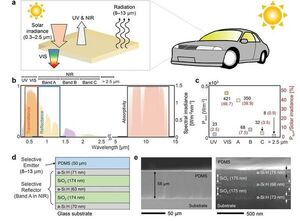
Visibly transparent radiative cooler under direct sunlight
"Since the Paris Climate Agreement that took effect in 2016, 121 countries have pledged to become carbon neutral by 2050 as the world tries to reduce its fuel consumption. The Korean government also unveiled its 2050 Carbon Neutral Strategy on December 7, 2020 and declared Carbon Zero, making transition to new and renewable energy a topic of conversation. Recently, a joint research team from POSTECH and Korea University has developed a radiative cooling material that can reduce energy consumption by selectively reflecting or transmitting sunlight. A research team led by Professor Junsuk Rho, Ph.D. candidate Minkyung Kim, and Dr. Dasol Lee of POSTECH's departments of mechanical engineering and chemical engineering, and a team led by Professor Heon Lee and Soomin of the Department of Materials Science and Engineering at Korea University have together developed a transparent radiative cooler that transmits visible light while reflecting near-infrared light, and radiates heat in the atmospheric window where the wavelength range is between 8 and 13 micrometers (μm). Recognized for its significance, this study was featured as the front cover paper of the latest issue of Advanced Optical Materials. Radiative cooling is a technology that lowers the temperature of an object by absorbing less energy from the sun and emitting radiant heat." [...]
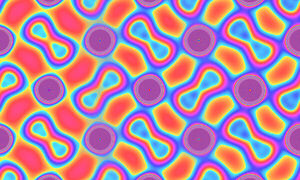
Under pressure, ‘squishy’ compound reacts in remarkable ways
"From insulator to metal and back again—a new transition phenomenon reported by Rochester and Las Vegas researchers ‘will find a place in physics textbooks.’ Remarkable things happen when a “squishy” compound of manganese and sulfide (MnS2) is compressed in a diamond anvil, say researchers from the University of Rochester and the University of Nevada, Las Vegas (UNLV). “This is a new type of charge transfer mechanism, and so from a science community point of view this is very, very exciting. We are showing remarkable physical transformations over a very, very short range of parameters, in this case pressure,” says Ashkan Salamat, associate professor of physics at UNLV. For example, as the pressure increases, MnS2, a soft insulator, transitions into a metallic state and then into an insulator again, the researchers describe in a paper flagged as an editor’s choice in Physical Review Letters. “Metals usually remain metals; it is highly unlikely that they can then be changed back to an insulator,” says Ranga Dias, assistant professor of mechanical engineering and of physics and astronomy at Rochester. “The fact that this material goes from an insulator to a metal and back to an insulator is very rare.” Moreover, the transitions are accompanied by unprecedented decreases in resistance and volume across an extremely narrow range of pressure change—all occurring at about 80 degrees Fahrenheit." [...]

Water as a metal - detected at BESSY II
"Under normal conditions, pure water is an almost perfect insulator. Water only develops metallic properties under extreme pressure, such as exists deep inside of large planets. Now, an international collaboration has used a completely different approach to produce metallic water and documented the phase transition at BESSY II. The study is published now in Nature. Every child knows that water conducts electricity - but this refers to "normal" everyday water that contains salts. Pure, distilled water, on the other hand, is an almost perfect insulator." [...]
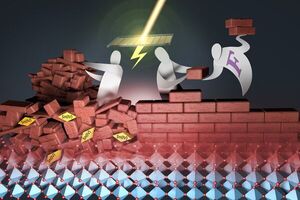
Lead-free perovskite solar cells - How fluoride additives improve quality
"Tin halide perovskites are currently considered the best alternative to their lead-containing counterparts, which are, however, still significantly less efficient and stable. Now, a team led by Prof. Antonio Abate from HZB has analysed the chemical processes in the perovskite precursor solution and the fluoride compounds in detail. Using a clever combination of measurement methods at BESSY II and with NMR at the Humboldt-University Berlin, they were able to show that fluoride prevents the oxidation of tin and leads to a more homogeneous film formation with fewer defects, increasing the quality of the semiconductor layer. Lead halide perovskite solar cells promise very high efficiencies at low manufacturing costs. However, the toxicity of lead poses serious environmental concerns, proving the need for lead-free alternatives. Tin is currently considered the best choice, but faces challenges regarding its oxidation and uncontrolled crystallization that restrains the respective solar cells in their production, performance and stability." [...]

UMD-led Study Reveals a ‘Fizzled’ Gamma-ray Burst
"Astronomers detect shortest gamma-ray burst ever recorded from a collapsing star NASA’s Fermi Gamma-ray Space Telescope detected a pulse of high-energy radiation on Aug. 26, 2020 that had been racing toward Earth for nearly half the age of the universe. Lasting less than a second, it turned out to be one for the record books—the shortest gamma-ray burst (GRB) caused by the death of a massive star ever seen. GRBs are the most powerful events in the universe, detectable across billions of light-years. Astronomers classify them as long if the event lasts for more than two seconds. They observe long bursts in association with supernova, explosions caused by the implosion of massive stars, while short bursts are thought to be the result of a merger between two neutron stars. Although this new GRB was merely 0.6 seconds long, analyses of the afterglow and the emerging light of the supernova that followed led an international team of scientists to conclude the GRB came from a collapsing star, not a merger." [...]

ITMO Scientists Create a Hopping Robot Using Morphological Computation
"The International Laboratory of Biomechatronics and Energy-Efficient Robotics has created a prototype of an energy-efficient hopping robot. The design is based on flexible joints and a series elastic actuator. Biomimetic principles A team consisting of Kirill Nasonov and Dmitry Volyansky, Master’s students of the Faculty of Control Systems and Robotics, supervised by Ivan Borisov, a research associate at ITMO University, is working on a galloping robot with unique morphological characteristics. The main task of the team is to develop a light, flexible, energy-efficient, and functional system. To achieve that, they use principles of biomimetics and morphological computation. According to Ivan Borisov, the goal is to create a device that would require as little control effort (energy) as possible, while being able to overcome uneven terrain, overcome obstacles, and be resilient to physical harm." [...]

Astronomers show how planets form in binary systems without getting crushed
"Astronomers have developed the most realistic model to date of planet formation in binary star systems. The researchers, from the University of Cambridge and the Max Planck Institute for Extra-terrestrial Physics, have shown how exoplanets in binary star systems – such as the ‘Tatooine’ planets spotted by NASA’s Kepler Space Telescope – came into being without being destroyed in their chaotic birth environment. They studied a type of binary system where the smaller companion star orbits the larger parent star approximately once every 100 years – our nearest neighbour, Alpha Centauri, is an example of such a system. “A system like this would be the equivalent of a second Sun where Uranus is, which would have made our own solar system look very different,” said co-author Dr Roman Rafikov from Cambridge’s Department of Applied Mathematics and Theoretical Physics. Rafikov and his co-author Dr Kedron Silsbee from the Max Planck Institute for Extra-terrestrial Physics found that for planets to form in these systems, the planetesimals – planetary building blocks which orbit around a young star – need to start off at least 10 kilometres in diameter, and the disc of dust and ice and gas surrounding the star within which the planets form needs to be relatively circular. The research, which is published in Astronomy and Astrophysics, brings the study of planet formation in binaries to a new level of realism and explains how such planets, a number of which have been detected, could have formed." [...]

Berkeley Lab Optical Innovation Could Calm the Jitters of High-Power Lasers
"The Berkeley Lab Laser Accelerator (BELLA) Center at the Department of Energy’s Lawrence Berkeley National Laboratory (Berkeley Lab) has developed and tested an innovative optical system to precisely measure and control the position and pointing angle of high-power laser beams with unprecedented accuracy – without interrupting or disturbing the beams. The new system will help users throughout the sciences get the most out of high-power lasers. The experimental validation effort was led by doctoral candidate Fumika Isono of Berkeley Lab and UC Berkeley. Her findings are described in a paper published recently by the Cambridge University Press journal, High Power Laser Science and Engineering. “This is a tremendous advancement in measurement and control that will benefit high-power laser facilities worldwide,” said Cameron Geddes, Director of Berkeley Lab’s Accelerator Technology and Applied Physics (ATAP) Division, of which the BELLA Center is a part. Measurement without disturbance People think of a laser as being so precise that it passes into the language as metaphor, but users with demanding applications know that laser beams move around at a tiny scale in response to the vibrations and variability of even the most controlled lab environment." [...]
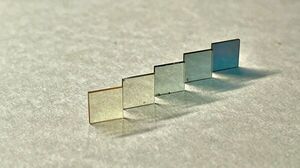
A new theory to explain the transparency of metallic oxides
"The electrons of some metal oxides, due to their large effective mass when coupled with the ionic lattice of the material, cannot follow the electric field of light and allow it to pass through the material. Transparent and conductive materials are used in smartphone touch screens and solar panels for photovoltaic energy. Researchers from the Institute of Materials Science of Barcelona (ICMAB-CSIC), propose a new theory to explain the transparency of metal oxides, which are used in the touch screens of smartphones and tablets as well as on the solar cells used in photovoltaic energy. Scientists point out that the effective mass of electrons in these types of materials is large due to the formation of polarons or couplings between the electrons in motion and the ionic lattice of the material, which is distorted around it. These electrons cannot rapidly oscillate following the electric field of light and let it pass rather than reflect it. Until now, the accepted theory to explain this transparency pointed to the interactions between the electrons themselves." [...]

What Goes Up Must Come Down: Fujitsu Helps To Clean Up Space With First-Of-Its-Kind Mission Optimiser
"Less than a year on from the UK Space Agency committing £1 million in funding to combat space debris, Fujitsu UK has successfully combined quantum-inspired computing and Artificial Intelligence to support the transformation of space debris removal. Fujitsu’s prototype –created in collaboration with the University of Glasgow, Amazon Web Services and Astroscale UK – will improve mission planning so that a single spacecraft can efficiently select which pieces of space debris to remove in one mission, and at a much faster rate than is currently possible. The removal of space debris is key to sustainability in space, reducing, or even preventing, the risk of obsolete spacecraft colliding with new and existing satellites. What’s more, supporting debris removal missions with Fujitsu’s technology will help to reduce the risk of catastrophic collisions in orbit which could create thousands of other pieces of new debris, all of which pose a very real threat to working satellites in orbit. By carefully deciding which debris is collected and when, the quantum-inspired offering, powered by Digital Annealer, optimises the mission plan to determine the minimum-fuel and minimum-time required to bring inoperable spacecrafts or satellites safely back to the disposal orbit. Finding the optimal route to collect the space debris will save significant time and cost during the mission planning phase, and also as a consequence will improve commercial viability." [...]
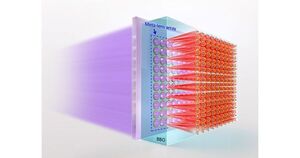
Researchers Create Powerful Quantum Source with Meta-lens Array
"Compact, practical approach paves the way for on-chip quantum information processing Researchers for the first time have demonstrated a quantum light source based on a meta-lens array. The approach offers a promising platform for both high-dimensional photon entanglement and the coherent control of multiple photons, making it suitable for advancing quantum technologies for secure communication, computing, and other applications. The work takes advantage of the ability to control light with tiny, precisely arranged nano/micro-structures patterened on an optical surface. The result is termed a metasurface. Din Ping Tsai from The Hong Kong Polytechnic University will present the research at the virtual OSA Advanced Photonics Congress to be held 26-30 July. Tsai’s talk is scheduled for 27 July from 19:00 – 19:15 EDT (UTC – 04:00)." [...]

On eternal imbalance
"Some physical systems, especially in the quantum world, do not reach a stable equilibrium even after a long time. An ETH researcher has now found an elegant explanation for this phenomenon. If you put a bottle of beer in a big bathtub full of ice-cold water, it won’t be long before you can enjoy a cold beer. Physicists discovered how this works more than a hundred years ago. Heat exchange takes place through the glass bottle until equilibrium is reached. However, there are other systems, especially quantum systems, that don’t find equilibrium." [...]
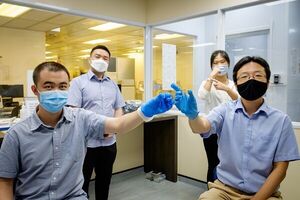
Paving the way for UV-enabled flexible wearable tech
"To enable the development of wearable devices that possess advanced ultraviolet (UV) detection functions, scientists from NTU Singapore have created a new type of light sensor that is both flexible and highly sensitive.While invisible to the human eye, UV rays surround us in our environment, and excessive exposure can cause health issues including skin cancer and premature skin ageing. The intensity of UV rays is typically reported through an index during weather reports. A wearable device, such as a T-shirt or watch that monitors the actual personal UV exposure throughout the day, would be a useful and more accurate guide for people seeking to avoid sun damage. In their study, which was featured on the front cover of the peer-reviewed journal ACS Nano, the NTU researchers reported that their flexible UV light sensors were 25 times more responsive, and 330 times more sensitive, than existing sensors, exceeding the performance level required for optoelectronic applications – or light-based electronics. The NTU team created their flexible UV light sensors on a semiconductor wafer 8 inches in diameter, using free-standing single-crystalline layers of gallium nitride (GaN) and aluminium gallium nitride (AlGaN), arranged using membranes that consist of two different thin semiconductor layers (heterostructure membranes). This type of semiconductor structure, which can be fabricated using existing industrial compatible methods, allows the material to be easily bent, making it ideal for use in flexible sensors." [...]

Collisions of Light Produce Matter/Antimatter from Pure Energy
"Study demonstrates a long-predicted process for generating matter directly from light — plus evidence that magnetism can bend polarized photons along different paths in a vacuum Scientists studying particle collisions at the Relativistic Heavy Ion Collider (RHIC)—a U.S. Department of Energy Office of Science user facility for nuclear physics research at DOE’s Brookhaven National Laboratory—have produced definitive evidence for two physics phenomena predicted more than 80 years ago. The results were derived from a detailed analysis of more than 6,000 pairs of electrons and positrons produced in glancing particle collisions at RHIC and are published in Physical Review Letters. The primary finding is that pairs of electrons and positrons—particles of matter and antimatter—can be created directly by colliding very energetic photons, which are quantum “packets” of light. This conversion of energetic light into matter is a direct consequence of Einstein’s famous E=mc2 equation, which states that energy and matter (or mass) are interchangeable. Nuclear reactions in the sun and at nuclear power plants regularly convert matter into energy. Now scientists have converted light energy directly into matter in a single step." [...]
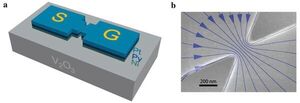
Scientists Invent a New Information Storage and Processing Device
"Scientists have developed a means to create a new type of memory, marking a notable breakthrough in the increasingly sophisticated field of artificial intelligence. Advance Holds Promise for Artificial Intelligence A team of scientists has developed a means to create a new type of memory, marking a notable breakthrough in the increasingly sophisticated field of artificial intelligence. “Quantum materials hold great promise for improving the capacities of today’s computers,” explains Andrew Kent, a New York University physicist and one of the senior investigators. “The work draws upon their properties in establishing a new structure for computation.” The creation, designed in partnership with researchers from the University of California, San Diego (UC San Diego) and the University of Paris-Saclay, is reported in the Nature journal Scientific Reports. “Since conventional computing has reached its limits, new computational methods and devices are being developed,” adds Ivan Schuller, a UC San Diego physicist and one of the paper’s authors. “These have the potential of revolutionizing computing and in ways that may one day rival the human brain.” In recent years, scientists have sought to make advances in what is known as “neuromorphic computing”--a process that seeks to mimic the functionality of the human brain." [...]

New cybersecurity technique keeps hackers guessing
"Army researchers developed a new machine learning-based framework to enhance the security of computer networks inside vehicles without undermining performance. With the widespread prevalence of modern automobiles that entrust control to onboard computers, this research looks toward to a larger Army effort to invest in greater cybersecurity protection measures for its aerial and land platforms, especially heavy vehicles. In collaboration with an international team of experts from Virginia Tech, the University of Queensland and Gwangju Institute of Science and Technology, researchers at the U.S. Army Combat Capabilities Development Command, known as DEVCOM, Army Research Laboratory devised a technique called DESOLATOR to help optimize a well-known cybersecurity strategy known as the moving target defense. “The idea is that it’s hard to hit a moving target,” said Dr. Terrence Moore, Army mathematician. “If everything is static, the adversary can take their time looking at everything and choosing their targets. But if you shuffle the IP addresses fast enough, then the information assigned to the IP quickly becomes lost, and the adversary has to look for it again.” DESOLATOR, which stands for deep reinforcement learning-based resource allocation and moving target defense deployment framework, helps the in-vehicle network identify the optimal IP shuffling frequency and bandwidth allocation to deliver effective, long-term moving target defense." [...]

Researchers Demonstrate Technique for Recycling Nanowires in Electronics
"Researchers at North Carolina State University demonstrated a low-cost technique for retrieving nanowires from electronic devices that have reached the end of their utility and then using those nanowires in new devices. The work is a step toward more sustainable electronics. “There is a lot of interest in recycling electronic materials because we want to both reduce electronic waste and maximize the use we get out of rare or costly materials,” says Yuxuan Liu, first author of a paper on the work and a Ph.D. student at NC State. “We’ve demonstrated an approach that allows us to recycle nanowires, and that we think could be extended to other nanomaterials – including nanomaterials containing noble and rare-earth elements.” “Our recycling technique differs from conventional recycling,” says Yong Zhu, corresponding author of the paper and the Andrew A. Adams Distinguished Professor of Mechanical and Aerospace Engineering at NC State. “When you think about recycling a glass bottle, it is completely melted down before being used to create another glass object. In our approach, a silver nanowire network is separated from the rest of the materials in a device." [...]

Twice the charm: long-lived exotic particle discovered
"Discovery of a new exotic hadron containing two charm quarks and an up and a down antiquark. Today, the LHCb experiment at CERN is presenting a new discovery at the European Physical Society Conference on High Energy Physics (EPS-HEP). The new particle discovered by LHCb, labelled as Tcc+, is a tetraquark – an exotic hadron containing two quarks and two antiquarks. It is the longest-lived exotic matter particle ever discovered, and the first to contain two heavy quarks and two light antiquarks. Quarks are the fundamental building blocks from which matter is constructed. They combine to form hadrons, namely baryons, such as the proton and the neutron, which consist of three quarks, and mesons, which are formed as quark-antiquark pairs." [...]
Documentação
A documentação é parte essencial do processo de aprendizagem e a Internet além de artigos interessantes de explorar também tem alguma documentação em formato PDF interessante de ler. Todos os links aqui apresentados são para conteúdo disponibilizado livremente pelo editor do livro.
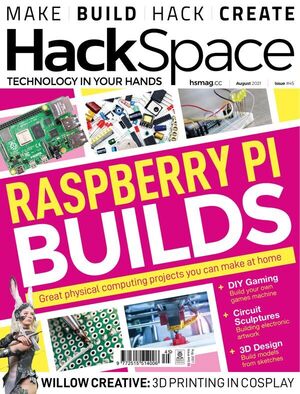
HackSpace magazine #45
"This issue we’re paying homage to some of our favourite projects built on the Raspberry Pi. We’re living in a golden age for experimentation, accessible making and digital discovery – and a large part of that is thanks to this teeny tiny computer. Just add imagination! - How one maker achieved perfection (yes, really!) by embracing failure - Our pick of the best walking robot kits - A deceptively simple hack for printing large objects (hint – you make the printer bigger) - Homebrew improvements to a cheap CNC machine - How to put an oak handle on an old kitchen knife - … and loads more" [...]

The MagPI 108
"Inside The MagPi magazine #108 - Award Winning Makes - Make games with Raspberry Pi - Create the ultimate home server - Develop an isomorphic keyboard - Build an arcade machine that streams games - Turn Pico into USB controller - 10 amazing wearable projects - Hack Bop-It to control Minecraft - Add wireless networking to a campervan - Win! Marty the Robot V2" [...]
Projetos Maker
Diversos Projetos interessantes.

Single-ended Video/Digital input to differential output driver (High-Speed Differential Driver)
"The project described here is a low-cost solution to transmit a video or digital signal up to 300 Meters over a twisted pair cable. The project has been designed using the AD8131 chip which is a differential driver for the transmission of high-speed signals over low-cost twisted pair or coaxes cables. The project can be used for either analog or digital video signals or for other high-speed data transmissions. It is capable of driving either Cat3 or Cat5 twisted pair or coax with minimal line attenuation. The AD8131 has on-chip resistors that provide for a gain of 2 without any external parts. Several on-chip resistors are trimmed to ensure that the gain is accurate, the common-mode rejection is good, and the output is well balanced." [...]

How to Access ESP32-CAM Worldwide using ngrok
"In the category of security products, you will see cameras known as ip cameras, which actually deliver the received images to the user through the cloud from anywhere in the world. In this tutorial, we are going to use ESP32-CAM boards and Cloud ngrok to build such a device with the ability to send images to different places without any restrictions. In fact, once the project is completed and launched, you will only be able to access it with a single link. What is ngrok ?! ngrok is a cross-platform application that enables developers to expose a local development server to the Internet with minimal effort. This software allows your local web server to be hosted under the ngrok.com domain, meaning that no IP or public domain name is required on the local device." [...]
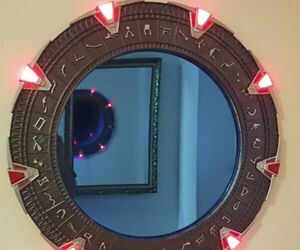
Stargate Mirror With Visual and Sound Effects
"Stargate is one of my favourite sci-fi TV show of all time. It is actually in top 3 together with Star Trek and Battlestar Galactica. A while ago my wife gave me an idea for a mirror, which will look like Stargate, so I decided to make it with few additions. As a huge fan of Arduino, I have designed a circuit with red LEDs for the chevrons and blue LED strip for the mirror frame. I have also added the mini mp3 player to play a Stargate theme song while red chevron LED's lights up every few seconds. All effects are triggered by PIR motion sensor hidden at the back of the mirror." [...]

Web Enabled, 3D Printed, Motorized Sliding Window Retrofit
"This 3D printed device will retrofit onto existing sliding windows to allow web enabled, motorized open/close function. Have you ever been driving to work in the rain, and wondering whether you've left the kitchen window open? Then you come home and your kitchen is all wet? Having this happen to me a couple of times helped to inspire this project. With some free time here and there, I've managed to put this project together over the last couple of years. There are still some quirks to work out, but hopefully this will help!" [...]
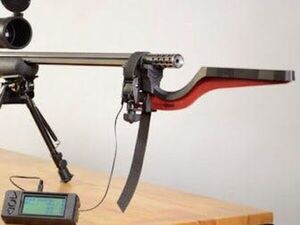
Kronograf
"A device that theoretically measures the speed of anything in meters per second. My project is to design a device that measures the speed of anything. This device, which will measure in meters / seconds, is generally referred to as a chronograph. It can measure with a 5% margin of error in theory, but in practice it has a margin of roughly 15% deviation. Because the transmission speed of electronic parts using ambient heat etc. This multiplies the margin of error." [...]

Joker Remote Hazardous Gas Station and Monitor
"Using an IR remote control, display the presence of hazardous gases w/ MQ series sensors and get notified when they reach dangerous levels. For a long time, I wanted to create a unique device to observe the presence of varying hazardous gases for a breadth of applications such as air quality monitoring and gas leak detection. Thus, I decided to develop this project. First of all, to elicit assiduous gas measuring results, I chose to utilize these MQ series gas sensors by connecting them to the Arduino Nano: - MQ-2 - MQ-3 - MQ-4 - MQ-6 - MQ-9 After choosing gas sensors for my device, I decided to control its settings and features with an IR remote control. Hence, I connected an IR remote receiver module to the Arduino Nano. Then, to display generated gas measurements, I used an ST7789 IPS screen." [...]
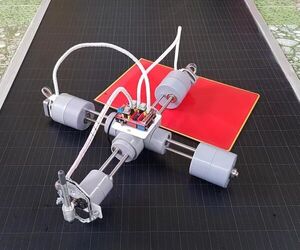
P-CNC Plotter Disguised As a Quadruped Robot
"This is my P-CNC plotter which is laid out and disguised as a quadruped robot. Today, I'd like to share how I made it. It was quite simple, no 3D printer required, just need my meticulousness, care and a little patience. Please check the brief description and how P-Plotter works in the video below before getting started. Main components are as follows: 1pcs x Arduino Uno R3 If you are new to Arduino, you can buy a kit named "Grove Beginner Kit for Arduino" with 10 additional Grove Arduino sensors all in one piece of the board. All modules are pre-wired, no breadboard and jumper cables required." [...]
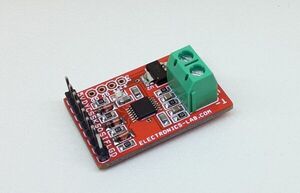
Precision Thermocouple Amplifier (Thermocouple to Digital Converter with Linearization – SPI Interface)
"This precision thermocouple sensor module performs cold-junction compensation and digitizes the signal from any type of thermocouple. The output data is formatted in degrees Celsius. The converter resolves temperatures to 0.0078125°C, allows readings as high as +1800°C and as low as -210°C (depending on thermocouple type), and exhibits thermocouple voltage measurement accuracy of ±0.15%. The thermocouple inputs are protected against overvoltage conditions up to ±45V. A lookup table (LUT) stores linearity correction data for several types of thermocouples (K, J, N, R, S, T, E, and B). Line frequency filtering of 50Hz and 60Hz is included, as well as thermocouple fault detection." [...]

Automated Home Appliance
"Designed a system which works as a Automated Home Appliance with BOLT WIFI MODULE which is power saying and even used as Fire alarm In this modern era we people look for Smart things like smart phones smart TVs etc. So in the same way I designed a smart appliance which is both smart and low power consuming which not only makes our work simple but also saves money. Along with which I designed another appliance which works as a Fire alarm which triggers us whenever there happens a fire accident in home. 1. Introduction This project "SMARTHOMEAPPLIANCE" has primarily two functionalities. · To turn ON and OFF the AIR CONDITIONER (let us take as yellow LED) basing on the Current trmperature readings ·Acts as afire alarm by switching ON and OFF Buzzer and RED LED *The first operation which is On and Off of AC is done by the LM35 temperature sensor which gives us current temperature values." [...]

Pinewood Derby Car Scale With Center-of-Gravity (CG) Calculation
"A key factor when building a pinewood derby car is its weight. The Boy Scouts of America and other organizations specify a weight of no more than 5 ounces. To improve performance many builders will add as much weight (mass) as possible up to that maximum allowable weight limit. What is often overlooked is the car’s center of gravity (CG) (AKA Center-of-Mass). Too far back and the car’s front wheels risk the possibility of jumping the track. Too far forward and you lose out on a few extra inches of acceleration during the downhill part of the track." [...]
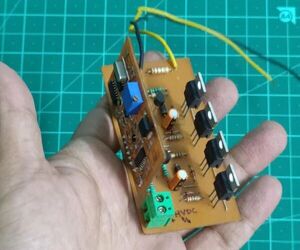
Make Your Own H-Bridge Circuit for Inverters
"Thank you for stopping by this article on making a H-Bridge circuit for converting DC voltages to AC voltage. This simple yet effective setup is very useful in inverter applications where we need to convert high voltage DC to 50 or 60 Hertz AC signal that can be used to drive out AC loads. Such H bridge is quite common in relatively cheap modified square wave inverters though this can also be used in pure sine wave inverters with appropriate modifications. Supplies IRF840 N channel MOSFETs - 4 MPSA42 or 13003 NPN BJT - 2 FR107 or UF4007 diode - 2 1N4148 general purpose diode - 4 47uF-25V electrolytic capacitor - 2 4.7K resistor - 2 2.2K resistor - 2 10K resistor - 2 22R resistor - 4 1MegaOhm resistor - 1 0.1uF/400V film capacitor - 1 2 pin Screw terminal - 2 Soldering kit and accessories PCB making items or verodoard ( depends upon how you want to make it)" [...]
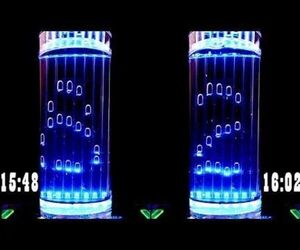
Glowing Air-Bubble Clock in Water
"“Glowing Air-Bubble Clock in Water” displays the time and some graphics by illuminated air-bubbles in water. - font: 8 bits width - display area: roughly 200mm height x 90mm width. - The viscosity of water is low and the bubbles rise too fast. Therefore, air is blown into the pipes, and the air-bubbles rise slowly enough to read the information displayed by the air-bubble group as they rise through the pipes. This “Glowing Air-Bubble Clock in Water” is the first version of my air-bubble clock. Basic idea is confirmed with this first model, and its basic specfications and technical items have been carried over to successor model version 2." [...]

Tasmota NodeMCU Alexa Smart Home System 2021 Without Coding
"How to make IoT-based Smart Home Automation with Tasmota Amazon Alexa & ESP8266 NodeMCU to control 4 relays from switches & Alexa app. I have shown how to make IoT-based Smart Home Automation Using Tasmota Amazon Alexa & ESP8266 NodeMCU to control 4 home appliances from the manual switch & Amazon Alexa Appin this IoT project. If the internet is not available, then you can control the home appliances from manual switches. This Tasmota ESP8266 smart home system has the following features: - Control home appliances with voice command using Alexa. - Control home appliances with manual switches. - Monitor real-time feedback in the Alexa App." [...]

OSU! Catch the Beat Game on Homemade 8x8 Matrix
"This is a simplified version of "Osu! Catch the Beat" game which is played on an 8 to 8 LED matrix. The game consists of catching the falling balls. The hunter moves left and right by turning the potentiometer. You have a total of 10 Lives, and you lose one for each missed ball. For every ball, you catch you get one life." [...]

ESP32 Home Automation
"Automating your house with the esp32 microcontroller to make a wireless light switch / alarm clock. in this project we'll see the steps needed to make a d.i.y home automation system: wirelss light switch, with alarm clock around the ESP32 microcontroller the wiring job is not hard, just follow the above wiring diagram. The code: The code consists of two parts, the HTML code for the web page, which will be embedded later in the Arduino code, and the Arduino code itself that displays / gets feedback from the page and the RTC module for the alarm clock, it's all explained with comments in the Arduino file above, so it shouldn't be hard to understand if you have experience with Arduino. At the end, your project should look a little something like the above image, you can choose any project box to contain it, just be careful when handeling the live 220v wires, it'll be best if you leave it to a professionel because every wiring job will be different depending on the house wiring itself, so you'll need to figure that out yourself. " [...]
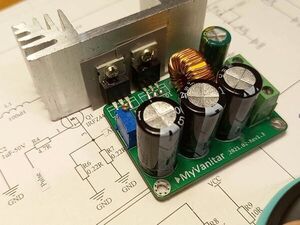
DC to DC Boost Converter using UC3843
"DC to DC converters are quite popular among electronic enthusiasts and are widely used within the industry. There are three major types of non-isolated DC to DC converters: buck, boost, and buck-boost. In this article/video, I used there major components such as the famous UC3843 chip, a power Schottky diode, and an N-Channel Mosfet to design a compact DC to DC boost converter. The input voltage could be as low as 9V that makes it suitable for a variety of applications, such as 12V to 18V conversion to power a laptop computer using a single 12V battery. I used Altium Designer 21 and SamacSys component libraries to design the schematic and PCB. The PCBs have been fabricated by the PCBWay in the green solder mask." [...]
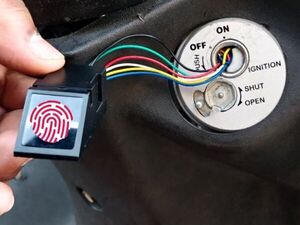
Make a Smart Unlock System for Motorcycle - Keyless
"In this blog, I am going to show you how to Make a Smart Unlock System For Motorcycle. This is a great project for people with minimal electronics skills, you can make this within an hour. This is an inexpensive and easy way to add fingerprint to any bike. this project we have made a fingerprint Scanner for Bike Ignition. We can start our bike with a fingerprint or a key. " [...]
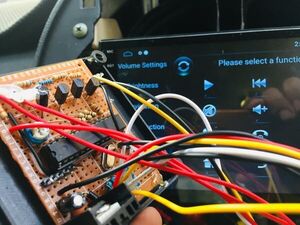
Car Steering Wheel Control Unit with Arduino
"Car Steering Wheel Control Unit with Arduino with two rotary encoders. " [...]

Upload Codes Wirelessly in Arduino Board with HC05 Module
"This Uploader eliminates the need to remove the circuit board from the PCB or circuit board. A USB cable is not even required to upload the code. Simply wirelessly upload the code whenever you like using a laptop or a desktop. Details for Bluetooth Module HC05 Bluetooth module HC-05 is used in this project. In addition to being inexpensive, it is also one of the most commonly used modules in many other projects. You should be able to obtain one from Amazon or eBay.com with little difficulty." [...]

Table Tennis Bat With Machine Learning AI
"Since the pandemic started, me and my housemates bought a Table Tennis table and started playing a lot of Table Tennis. I made this project so that I could monitor and test how well I perform my shots based on what the device is telling me, so that I could improve my game. I use the Arduino Nano 33 BLE Sense and TensorFlow Micro with the Tiny Motion Trainer "Experiment" developed by Google Creative Labs for this project. Parts for the project: - Arduino Nano 33 BLE Sense - SparkFun LiPo Charger/Booster - 5V/1A - Battery (LiPo) 3.7V 400mAh - Stranded Wire 26 AWG - TPU Filament Equipment: - 3D printer - Soldering Iron + solder wire - Wire cutter - Mac/Windows/Linux PC" [...]
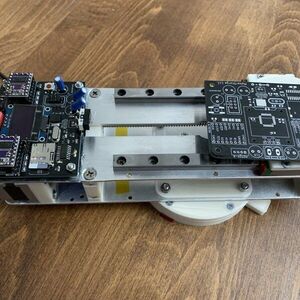
PnPAssist
"PnPAssist is a tool that helps you to assemble PCB boards manually. The PnPAssist is an open source innovative CNC table that position the next SMT component with a proper orientation for you to make hand assembly a lot more fun and way more efficient. PnPAssist is a numerical, precise positioning device that makes tedious and repetitive manual PCB assembly easier for you and prevents you from making mistakes. Why I build this? I often find myself assembling PCB boards that I designed for my own R&D activities or for a small number of boards I prepared for sale on Tindie. This process is a little bit painful." [...]
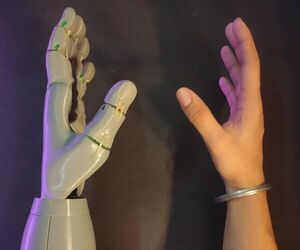
Cyborg Hand : Robotic-cum-Prosthetic Servo Powered Hand
"For this Instructable you will need: 1- 3d Printer 2- CAD software( TinkerCad / Fusion360 ) 3- PLA and TPU filament 4- Servos [ MG995 ] 5- Arduino 6- Wires and Breadboard 7- Rubber bands 8- Thread / String ( nylon preferred ) I was always inspired and thrilled after seeing movies on robot or movies which had robot in them from Wall-e to Iron-man to Alita: battle angle . I am also very enthusiast about robotics and believe that we can improve our life with the help of robotics. We can be like cyborgs and do some heavy or complex stuff easily. I also am an Engineering student so I thought lets build a Robotic-cum-Prosthetic Hand that can be used in both purposes with a few to no modification. So here I have designed a Robotic hand inspired and taken idea from two different open source projects and added my inputs and design to it to fit the purpose. The arm is build using completely 3D printed parts." [...]
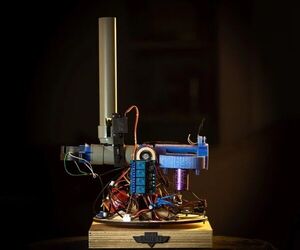
Arduino NERF Ball Wireless FPV Sentry Turret
"This project will guide you through the steps to make an Arduino based 360 degree rotating foam ball turret with full joystick wireless control, and first person view camera and headset. This is a moderately complex project for hobbyists looking to try something a little extra. Parts of this project were limited by component availability and time, so we encourage you to make it your own and modify and improve the design. You can follow step by step, use bits of it, or just the code, to make your own foam ball turret. This project will involve: Basic woodworking Basic metal working Soldering Arduino programming 3D printing Laser cutting (or patient sawing by hand) Coding skills you'll get to try out: Wireless communication Brushless motor control Servo control Supplies 250 x 250mm heavy wood About 600 x 300mm 6mm plywood Arduino Uno - £17.00 Arduino Nano or Nano Every - £10.00 7.4V 3800mAh LiPo battery - £35.57 2x Brushless 1980KV motors - £21.70 each 2x ESC motor controllers - £13.41 each 2x 2.4GHz WiFi module + Shield - £2.60 each Compatible Joystick (an old 15 pin Logitech Wingman works great, anything simple that uses potentiometers) - £5.99 Voltage step-up converter - £3.99 5V Arduino Relay - £5.49 47mm O.D Thrust Bearing - £14.03 2x 26mm O.D Axial Bearings - £3.06 each 10mm Aluminium Rod (or similar) 25mm plumbing pipe and Right angled 3 way adapter Plastic 70mm O.D Wheel set (for Firing) - £4.20 MG996R 360 Degree Servo (for Rotation) - £9.00 MG946R Servo (for Tilt) - £8.00 DS329HV Servo (for Trigger Firing) - £7.89 2x DF5015SM 12V Blower Fan - £2.48 each FPV Camera - £16.99 (optional) FPV Headset - £43.99 (optional) 3D Printer Laser cutter (or hand saw and some patience) Total Cost: £268.64 (much cheaper if you already have parts lying around) 3D printed parts: 360 degree servo mount Tilt servo mount Launch wheel / motor holder Blower fan holder Barrel holder Servo to shaft mount Camera Mount" [...]
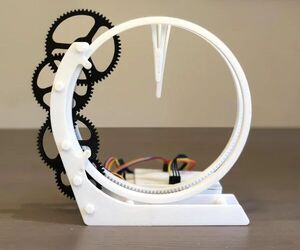
3D Printed Holo Clock With Arduino
"This project is a 3D printed clock powered by a stepper motor and is controlled by an Arduino Uno. It was designed in OnShape over the course of a month. It keeps time very precisely and only needs to be plugged into a USB port once programmed. Supplies - Arduino Uno - 24BJY-48 stepper motor - ULN2003 stepper motor driver - 6 male to female jumper wires - A 3D printer - 2 different colors of filament (I used black and white PLA+) - 2 M4 nuts - 2 M4 screws 6mm long - 4 M3 screws 10mm long - 8 M3 washers - Masking tape - Super glue - M4 and M3 allen wrenches - 3.18mm x .335mm brass tube" [...]

Smart Thermometer Using Esp-01F and Web Socket
"In one of the previous instructable, we saw how to make a simple thermometer with ATTINY 85 which can last for 140days with a single battery and it still works great after 40+ days with the same battery I showed in the video. But it was a tiny bit clumsy when it came to the electronics and the programming. So, in this instructable, let me show you how to make a thermometer on steroids with features nobody asked for, but by doing so I hope you will definitely learn plenty of electronics along the way. The device will have the following features: - Realtime reading using WebSockets - Auto sleep on when not in use - Control the thermometer from a webpage - Sleek PCB design - Integrated esp-01F programmer - Integrated lipo charging circuit - 3d printed case These are the list of products that can help you do this project with ease - ESP-01F - SMD Resistor - SMD Capacitor - BC817 transistor - CP2102 IC7F - TP4056 ICQz - SMD LED - Voltage regulator - Micro USB - White PLA - PETG filament - DS18B20 - OLED display - Resistor Kit - 3d Printer - Printer Upgrades" [...]
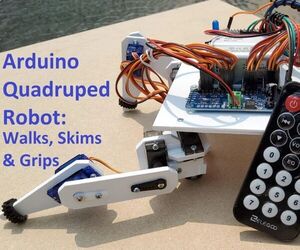
Arduino Quadruped Robot: Walks, Skims & Grips
"I made an Arduino quadruped robot by-hand, meaning without a kit or a 3D printer. It walks using a "long step" gait, which can be very smooth and natural looking. It didn't quite come out the way I wanted though. However, to make my robot unique, I had the idea to create a skimming-type motion along the floor, similar to the way that boatman water beetles swim. In all my searches online, I have not come across a quadruped robot that has been programmed to move in this way, so this may be the first of its kind published online (?). The skimming motion is an awkward, jerky way to move, but is super fun and much faster than walking." [...]

Arduino Memory Game
"This is a project that was started 2 years ago which I recently decided to pick up again and finish. The purpose of the product is to test a person's ability to memorize patterns. It does this on a 2x2 button layout where the user must replicate the LED pattern that is shown. With each successful entry, another element to the pattern is added and the level of difficulty increases (indicated by the number displayed at the top). A video displaying the functional product can be found at the end of the Instructable. Supplies Tools - Drill Press - Compound Mitre Saw - Clamps - Laser Cutter - Soldering Iron - Wire Cutter/Stripper - Table Saw - Computer Hardware - PVA - Teak Wood - 4x Wood Screws (any suitable size) - Black Acrylic Electronics - 4 PTM Buttons - 12x 10K Ohm Resistors - 18x 470 Ohm Resistors - 8x Diodes - 2x 7 Segment Displays - PCB Board - 2x 4511 IC - Perf Board - 5V Adapter - Arduino Nano - Arduino Nano Expansion Board (Optional) - 4x LEDs - 4x LED Sockets" [...]

CliSensio - Climate Sensing and Insect Infestation Control
"Climate Change, a highly debated high school topic, but do we really care about it? We see politicians, scientists, researchers, philanthropists, conservationists and almost everyone blaming each other for every climate catastrophe occurring today. The real question is what climate change or change are we talking about? CliSensio - Climate Sensing and Insect Infestation Control is a new adaptive device that runs SensiML AutoML audio recognition on the edge to recognize disease spreading vectors, hungry pests and threatful species. CliSensio device firmware can be flashed for mosquito species identification, pest, rodents identifications and elimination responses. Change is never easy for any species or life form but it happens in order to survive and evolve and this is the change we need in order to challenge climate change - the change could be in form of laws to reduce carbon emissions, conserve biodiversity, advanced technologies which can outperform existing techs in terms of greener energy or total innovative revamping of traditional ways of all human activities." [...]

Tactile Interface Thermometer-Clock
"A Thermometer Clock with no screen, numbers or visible interface. I made this device, a thermometer-clock without screen, buttons, needles or any visible interface. It may not be the most practical device, but we can’t deny that it’s a cool idea. I think it might be a good device for people who live far from home and want to feel a "physical" bond with their place of origin. It's based on a NodeMCU, a peltier plate and a solenoid, and uses a PID system to reach the target temperature accurately. " [...]
Secção Videos
Videos interessantes.
That's all Folks!





